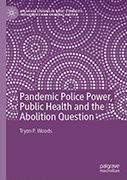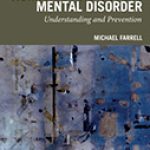Pandemic Police Power, Public Health and the Abolition Question

Author: Tryon P. Woods
Publisher: Palgrave Macmillan, 2022. 277 pages.
Reviewer: Chuck MacLean | December 2022
Persuasively written and ferociously researched, University of Massachusetts Associate Professor Tryon Woods’s Pandemic Police Power, Public Health and the Abolition Question presents an impassioned argument that all police power – including public health “police power” during the COVID-19 era – is arrayed against Black persons as a mechanism of social control. But the volume also strikes a somewhat schizophrenic tone containing both a richly, if unobjectively, supported diatribe against the U.S. criminal justice system as racist and anti-Black – and then, as if from a separate volume, an extensive public health assessment of the U.S. COVID response and focuses on its vaccine, lockdown, and masking, while ignoring what the author claims as scientifically proven alternatives, including, notably, ivermectin and hydroxychloroquine. Thus, the volume is both pleasing and persuasive on the one hand, while also cloying and cobbled together on the other.
Over the first three chapters, Woods indicts U.S police, online education, housing, technological advancements, health care, STEM, the Internet, corporations, Fourth Amendment jurisprudence, and STEM education (this is a subset of his targets) as inherently slave-rooted and anti-Black. Of course, there exists and Woods offers extensive scholarly support for each point he proffers, but Woods’s approach suffers from a lack of leavening when he fails to present, discuss, and address opposing analyses, other than what appears as a rather dismissive wave of his hand. Given Woods’s one-sided approach, his view that economic policy, housing markets, police, prisons, technology, and virtually all other features of modern America disfavor only Black persons leaves this reader to wonder why Woods largely ignores that America’s blessings have been denied to other groups, as well.
Indeed, the Woods argument reveals that policing is at the core of, or is at least descriptive of the majority of, inequality suffered by Black persons and communities, while simultaneously cursing modest efforts made to improve this mistreatment. Spanning many examples, Woods claims and proclaims that the Civil War was fought to institutionalize slavery – not end it; police defunding and prison abolition magnify inequality, rather than diminishing it (e.g., “abolition produces enslavement, not the other way around”); Brown v. Board of Education and integration demeaned, rather than honored, Black students; restorative justice approaches are social control tactics in sheep’s clothing; policing is not just derived from slavery, but is slavery; contract law elevated illicit slave contracts, but “render[ed] any contracts that conflict with slavery’s extralegal compacts secondary or null and void;” “the modern world is oriented to its very core to negate black humanity;” slavery is the “essence on which law turns;” “slavery was never a matter of law; but the law has always been a matter of slavery;” the post-Civil War amendments all exacerbated slavery rather than serving to limit and end slavery; the roots of inequality in the U.S. criminal justice system were crafted through and accelerated by liberal reform efforts; and it is “simply the persistent tyranny of antiblackness that continues to underwrite democratic governance.” This sole focus on Black inequality in the criminal justice and economic/housing systems, rather than all inequality, therein unfortunately set a tone for the volume that it would be focused on a single interest group, rather than on improving the criminal justice, economic/housing, and public health systems for all. Furthermore, the author’s insistence that reform efforts are misguided or have proved to be effectively drivers of inequality left this reader with a sense of despair, rather than a sense of purpose. The volume was, in that sense, an opportunity lost.
The latter half of the book focuses on the U.S. governmental and public health responses to COVID-19. In short, Woods argued that they got the science wrong; PCR (polymerase chain reaction) testing has overestimated COVID cases by ten-to-twenty times; “people are dying with COVID-19 (at best), not of it”; COVID vaccines are dangerous, unproven and weaken, rather than protect, those receiving them; and moneyed interests drove the U.S. toward unproven vaccines and masks, and away from purportedly proven alternatives, such as hydroxychloroquine and ivermectin. Copiously cited, this part of the book came across as a pet project, or a pet peeve, rather than a neutral and scientific assessment of the alternatives. Very little effort was taken to present opposing viewpoints preferring, instead to support only Woods’s own arguments against vaccines. That left this reader with the sense that the volume’s and author’s central flaw was a preference for confirmation bias over objectivity.
Indeed, the author’s COVID-related pronouncements were stark and strident: PCR “grossly exaggerates the problem at hand”; we do not have a COVID problem – we have “a public health situation . . . produced by the medical industrial complex”; the asymptomatic transmission theory is a manufactured anti-scientific mirage; COVID public health protocols – including lockdowns, masking requirements, social distancing, and closing schools – do not work because COVID statistics are mere artifacts of the hopelessly misapplied PCR testing approach; the mRNA-based COVID-19 vaccine approaches have never been applied globally to humans and “are, in fact, doing more harm than good”; “racism is intrinsic to the vaccination imperative”; Supreme Court decisions have given “license to the eugenics movement’s focus on vaccination as its preferred methodology for reproducing facial dominance in the twenty-first century”; favoring expensive vaccine approaches over less-expensive, and more readily available, options disadvantage poorer communities and regions and border on giving rebirth to eugenics; vaccines have been credibly linked with causing myalgic encephalomyelitis, HIV, autism, and cancer; and “[i]n short, COVID-19 is definitely dangerous for people over 70 years old . . . [f]or everyone else, it is proving to be on par with the seasonal flu.” By now, the reader of this book review may be feeling a bit as I felt reading the book: this is really several books cobbled together into a single volume too strident, multi-focused, and one-sided to be truly transformational and help move thought leaders and policy makers.
Woods argues that “anti-Black societies like the United States . . . systematically destabilize black communities and society to the tune of every poor health indicator and manner of premature death, and then rush to fill the void with costly and suspect pharmacological and biotechnological antidotes.” As just one example, Woods claims that some public health planners, in prioritizing treatments and interventions to Black individuals and communities, are simply echoing early twentieth century eugenicists, essentially setting up Black persons as targets of “racial sacrifice.” Even the public health tracking of COVID infections draws the ire of Woods as he labels that as just a new incarnation of the country’s racist plan to surveil Black bodies.
The vitriol and mono-focus on Black targeting and Black disadvantage left this reader wanting a more even-handed and nuanced presentation. There is, of course, room for anger and vitriol in disclosing and attacking Black persecution and inequality, but to my eye persuasion flags when stridency trumps objectivity.
Woods concludes his manifesto with a warning and call to action. He argues the public health system sanctions “scientific corruption, profiteering, and widespread harm” while perpetuating antiblackness as central to White social control. He argues the people should “inundate the courts with challenges to every facet of the pandemic police power, from vaccine mandates to takings without just compensation.” At bottom, Woods argues that abolitionism should be extended to challenge and disempower medical science of which Black persons are far more often victims than beneficiaries. As Woods argues, “People need to realize that their health is in their hands; when we cede this power to the medical and public health institutions, our communities end up suffering for it.” Such hyperbole passes for argument, but ignores the apparent successes of public health and COVID policies in saving lives, preventing disability, and hastening the return to pre-pandemic routines. And that hyperbole credits inaction at the federal and CDC levels, most notable in the Trump era, and empowers amateur researchers with little or no scientific background or training to Google their way to opinions contrary to those pandemic scientists who have devoted their careers to studying and mitigating viral pandemics.
All that said, this is a stunningly well-written book, engaging to read while disclosing, demonstrating, and documenting a veritable parade of racist and Anti-Black connections and patterns that cry out for remedy and attention across the criminal justice system, housing, economics, and public health. The book presents a clearly knitted fabric of anti-Black animus in constitutional, criminal justice, medical science, COVID-related policies, and economics/housing that is compelling, though one-sided.
Further, Woods’s extensive and thoroughly researched and defended views on pandemic and COVID science and policy are fascinating and thought-provoking, as they provide an analytical veneer and deeper substance to the often vapid and superficial anti-vaccine and anti-CDC (U.S. Centers for Disease Control) rhetoric poisoning much of social and mass media. Woods has obviously and deeply thought this through and offers the receipts, as it were, so that we all must think more critically about our almost hesitation-free reliance on the CDC, virologists, and leading pandemic scientists. There is another side to the COVID era – and in this book, Woods offers that other side with true substance.
Charles E. “Chuck” MacLean, J.D., Ph.D., is a Professor and Director of Professional Peace Officer Education at the Metro State University School of Law Enforcement and Criminal Justice, Brooklyn Park, Minnesota USA.


